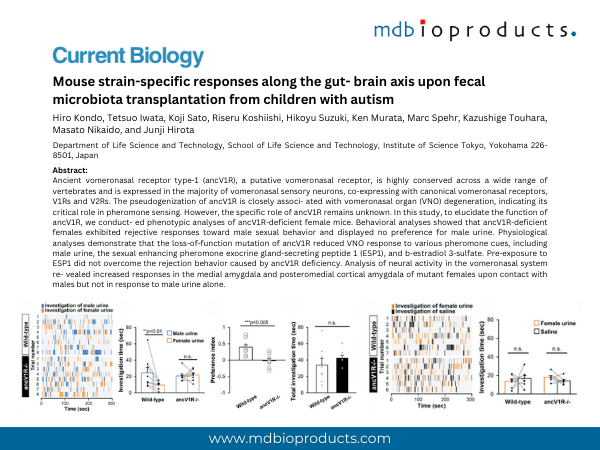
Featured Publication in Focus: Impaired pheromone detection and abnormal sexual behavior in female mice deficient for ancV1R
Mar 06 , 2025
Authors:
Hiro Kondo, Tetsuo Iwata, Koji Sato, Riseru Koshiishi, Hikoyu Suzuki, Ken Murata, Marc Spehr, Kazushige Touhara, Masato Nikaido, and Junji Hirota
Department of Life Science and Technology, School of Life Science and Technology, Institute of Science Tokyo, Yokohama 226-8501, Japan
Elsevier Inc. Current biology
----------------------
Product referenced:
Catalogue # M046006
----------------------
ABSTRACT
Ancient vomeronasal receptor type-1 (ancV1R), a putative vomeronasal receptor, is highly conserved across a wide range of vertebrates and is expressed in the majority of vomeronasal sensory neurons, co-expressing with canonical vomeronasal receptors, V1Rs and V2Rs. The pseudogenization of ancV1R is closely associ- ated with vomeronasal organ (VNO) degeneration, indicating its critical role in pheromone sensing. However, the specific role of ancV1R remains unknown. In this study, to elucidate the function of ancV1R, we conduct- ed phenotypic analyses of ancV1R-deficient female mice. Behavioral analyses showed that ancV1R-deficient females exhibited rejective responses toward male sexual behavior and displayed no preference for male urine. Physiological analyses demonstrate that the loss-of-function mutation of ancV1R reduced VNO response to various pheromone cues, including male urine, the sexual enhancing pheromone exocrine gland-secreting peptide 1 (ESP1), and b-estradiol 3-sulfate. Pre-exposure to ESP1 did not overcome the rejection behavior caused by ancV1R deficiency. Analysis of neural activity in the vomeronasal system re- vealed increased responses in the medial amygdala and posteromedial cortical amygdala of mutant females upon contact with males but not in response to male urine alone. Additionally, upon male contacts, ancV1R- deficient females exhibited increased neural activity in the lateral septum, a stress-associated brain region, along with elevated stress hormone levels. Such effects were not observed in females exposed solely to male urine. These findings suggest that, in females, ancV1R facilitates VNO responses to pheromone stimuli and plays a crucial role in perceiving males as mating partners. The absence of ancV1R results in failure of male perception, leading to abnormal sexual behaviors and stress responses upon male contact.
To continue reading and to download the publication:
